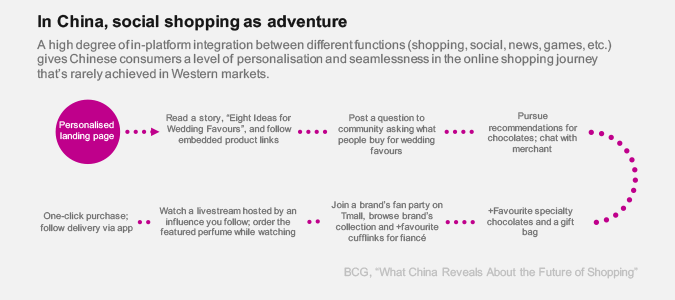
Over the past decade, social media have opened up a world of connection, allowing people to communicate, share ideas, activities, events, play games, listen to music and more. So it’s not surprising that this ecosystem is fast becoming crucial real estate for brands vying to reach potential new customers by creating seamless shopping experiences through native ecommerce. But where do the biggest opportunities lie and what actions can brands take to win in this new world of shopping?
Kantar Consulting’s Global MONITOR shows that 36% of people globally prefer to seek advice from social media and forums when considering products and services, showing that social media is increasingly influential on people’s purchase decisions. And this opportunity is sizable – according to a recent article from Business Insider, the top 500 retailers globally earned an estimated $6.5bn from social shopping in 2017, an increase of 24% from 2016.
Those hoping to tap into social commerce need to understand the key ingredients to delivering an excellent in-app shopping experience and how to reach the generation most willing and eager to buy through platforms – Centennials (those aged under 21).
Much like shoppers in China’s cities, where a tech and social savvy audience barely carry cash, and shopping on social networks is growing faster than shopping at the mall, Centennials in the West are mimicking similar behaviours, making them a lucrative group to watch as social commerce evolves. Interesting to note too, that people in many emerging markets are not just ahead of the West, but virtually skipped our model of commerce completely: leapfrogging from small, local shops, to mobile first social commerce as it is today, with big-box physical retail playing nothing like the role it once had in Western markets.
A recent report** on this youngest generation found that this group represents more than 35% of the world’s population and in 2018, will have a spending power of $200bn. Brands will need to keep up, providing shopping experiences that fit with this group’s love of online shopping and social media to stay competitive.
So what must brands do to ensure they understand and serve all elements of this group’s potential routes to purchase: from browsing in traditional bricks and mortar stores, to ultimately converting sales on social?
Social commerce mostly serves one of two purposes: to make shopping more efficient, or facilitate an adventure. The particular market, category and moment will determine the need which social commerce should be looking to fill.
i. Efficiency is self-explanatory. A seamless, curated experience that allows people to complete their mission with minimal friction and effort. It's key to driving impulse purchases too. In many categories people are overwhelmed with product choice, and some category disruptors have seen this an opportunity to specialise in just a few products or designs. One such innovator is Casper, an online mattress company that is thriving as the simplicity of their product range takes away the painstaking task of choosing a mattress.
ii. For many, buying through social is about adventure and only one step in a meandering, content-led journey. Adventure is more complex: an online journey that might include research, browsing and seeking the opinions of influencers, this mode of purchase is all about reducing the risk of ending up with products that are unsuitable or don't deliver.

Both of these needs (or purposes) should be driven by people. Social is a very personal space, and in-your-face ‘buy now’ call-to-actions can be disruptive. Instead, look to create useful shopping experiences that integrate seamlessly into a social network’s content, rather than intruding upon it.
MikMak is a social video commerce platform that enables brands to sell directly to people on Facebook, Instagram and Snapchat, providing these users with a seamless purchase experience without leaving the social platform.
Critical to the shift to social commerce will be the ability to establish trust in buying through social platforms. Barriers vary by market and category, but include concerns about product quality, secure payment, use of personal data, reliable delivery, product quality and returns. Work out what your trust issues are and find ways of reassuring people.
For example, trust barriers can arise if people are faced with an unfamiliar payment method when buying through social channels. To overcome this, high street fashion retailer All Saints adopted Amazon Pay as their payment method, knowing that Amazon is a trusted brand and enabling people to purchase clothing directly through Instagram securely without leaving the app.
A trusted and tailored social experience for tomorrow’s shopper
Understanding Centennials’ behaviour on social media provides brands with insight into the shopping habits of the future. Brands who can get the social experience right – emphasising customer care, building trust and designing the right kind of social shopping experiences – will be poised for social commerce success.
